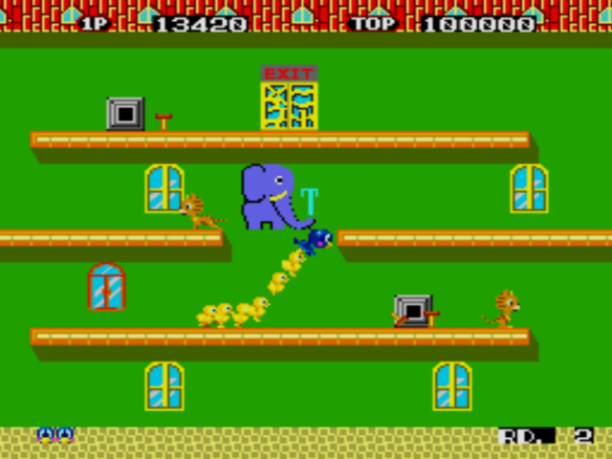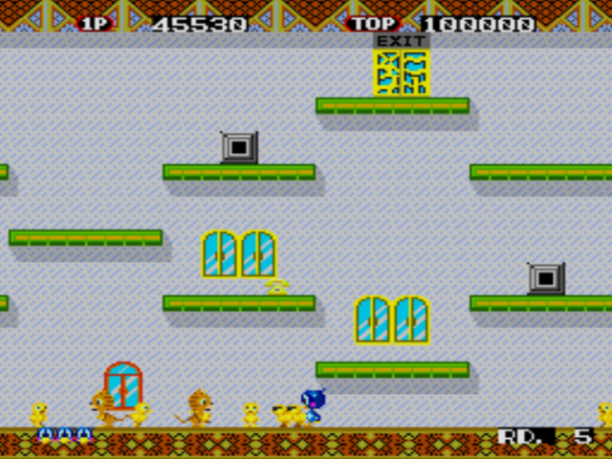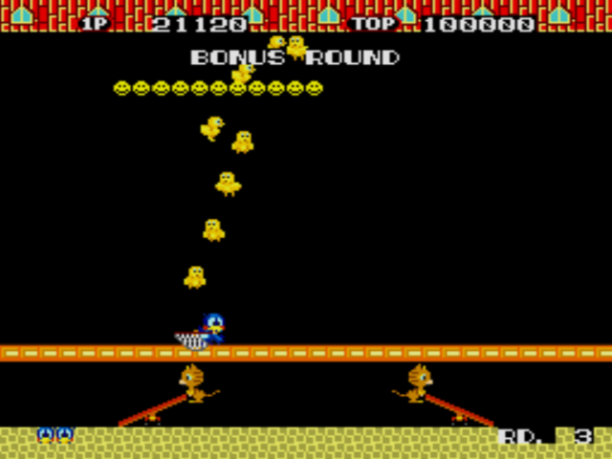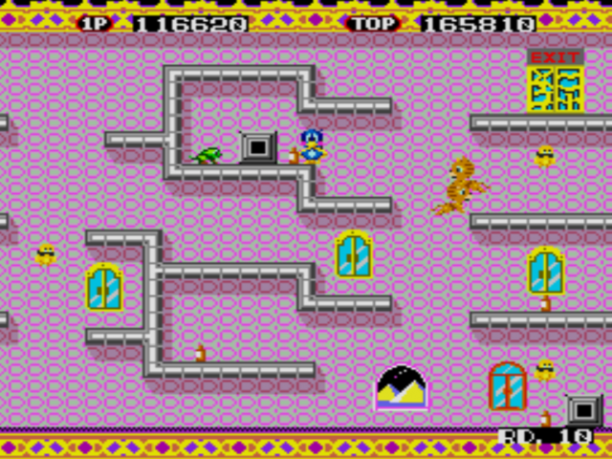
Pixel Gallery
Flicky
Retro Platforms: Arcade, FM-7, MSX, NEC PC-8001, Sega Genesis, Sega SG-1000, Sharp X1
Platform Reviewed: Sega Genesis
Many people seem to know about Sonic the Hedgehog, the side-scrolling franchise that features everyone’s favorite anatomically incorrect hedgehog. Less discussed, however, are the little birdies who this apparently two-legged mammal rescues from the mechanical innards of bizarrely shaped robots; most of them being known as Flickies, these winged beasts may be critters of distress in the Sonic the Hedgehog series, but one of them actually starred in an arcade game before the fastest thing alive was even a concept. Tasking the player with rescuing a bunch of chicks from a mall-like area, all whilst avoiding vicious cats and pesky iguanas, Flicky has some intriguing gameplay mechanics, but the game isn’t without its ups and downs.
Graphics
Flicky has a simple visual style that might be lacking in complexity, but it’s easy to focus on the action. Before starting the first level, you’re introduced to a simple title screen that introduces the characters, followed by a single still image that explains the rules of the game; the latter isn’t really necessary, but it’s brief enough. The stages themselves take place in what seems to be a maze-like shopping mall, using different physical layouts for separate levels while sometimes switching up the colors. Platforms have identifiable borders, decorative ceilings and floors (including stone and brick-like drawings) surround the level design, and gameplay-related objects are easy to spot; airborne terrains also have shadows, adding some appreciated graphical depth. On the downside, background objects tend to feel copy and pasted, and the walls are uninspired, being limited to a single color (or unimaginative texture pattern) at a time. Text effects, despite immediately updating, are also surrounded by black rectangles; these slightly obstruct small parts of the screen.
Although the backgrounds aren’t great, the characters animate fluidly, and everything moves in a fast manner. The bird heroine can run, fall down pits, and jump around in the air; all of these actions are drawn without any input lag. What’s more interesting is how friction is built into the visuals as well: there are different sprites used when slowing down, and momentum is maintained when you bounce off of walls. Another mechanic in the game involves tossing objects: these slide around on-screen to match with the fast action. Really, just about everything in this game runs quickly, and it makes navigation intense. The game’s also capable of drawing a bunch of characters that can act separately of one another, so it’s impressive to see this level of object handling. Collision detection is friendly too, and my only real complaint with the sprites is that there could be more of them.
Audio
I have trouble deciding whether Flicky’s music is delightfully cheerful, or instead utterly maddening. Why I might lean toward the latter is due to multiple reasons: there’s hardly any musical variety, the main gameplay theme loops early and constantly, and everything sounds high-pitched in a way that sounds like it belongs at a trippy carnival. However, I like the music at times for other reasons: there are multiple instrumental layers, everything’s suspiciously happy, and the main stage song, despite being incredibly short, has a hyper tempo that matches the speed of the gameplay. There are also some brief jingles that play during the opening, bonus stage, and high score screens, as well as whenever you die; the music transitions are pretty smooth too.
Flicky’s sound effects also have a happy mood, but they tend to feel repetitive. For instance, jumping replicates a bird-like noise, but one that gets a little annoying after playing too often. Other sound effects are basic but varied, and actions ranging from reaching an exit to tossing a pot all have their own noises; they get the job done well. A bigger problem, though, is that half of what should have sounds don’t: reactionary sounds like hitting a wall, or having chicks be separated from the group, aren’t present in the gameplay. Sounds like this aren’t needed for the gameplay to work, but it’s weird to play a bonus round that involves chicks launching upwards, and yet said bonus round only plays sound effects for two things: collecting chicks, and jumping.
Gameplay
Flicky initially appeared in arcades, and the game certainly fits into the arcade genre: progression is made on a level-by-level basis, points are a main focus, and stages are short but require quick reactions to avoid losing lives. Every level starts you at an exit, but the gameplay requires you to first run into a number of yellow chicks before then leading them to said exit. Once rescued, the chicks are removed from the field, and you earn points based on how many you’re able to bring back at once; the score bonuses increase exponentially with higher chick amounts. This significantly affects the strategy elements of the game, as you have to decide between risking level progress for higher score amounts (which can lead to extra lives), or rescuing only a few chicks at a time for safety purposes. If an enemy touches you, then you lose a life, and following chicks scatter around the level for you to pick up again; enemies can also run into these chicks, which doesn’t harm them but still separates them from the current line. This balancing system leads to rapid decision-making, and since both approaches have pros and cons, it adds some very welcomed depth to the gameplay. In addition to the chain bonuses, you can also earn points from time bonuses and picking up occasional diamond drops from defeated enemies; this makes speed another factor to consider while playing, although it’s not one that I was focused on as much.
There are two kinds of enemies: vicious cats (who run and jump around the stages), and mischievous iguanas (who move and jump along the sides of platforms). While they don’t immediately home in on you, they’re formidable enough threats, and there are usually multiple present on the screen at once. Because they can also separate a group of chicks, the game encourages you to not only think about how they might be an immediate threat to staying alive, but also how they could actively influence your attempts to maximize your score. See, depending on how greedy you feel, moving around also involves thinking about how the group behind you moves, since there’s an intentional yet slight delay to when they’ll follow your actions. Some people might find this a little stressful, and it can feel sort of awkward in tighter spaces that require lots of pauses in order to turn around, but it also adds more complexity to a real-time system. The biggest strength of Flicky’s gameplay is its plan-your-own-route design; this also varies up consecutive playthroughs.
But as you can imagine, since birds and cats aren’t exactly the best of friends, one would hope there’s a way to fight back against the vicious felines. Fortunately, you can pick up and toss scattered objects at them; however, the throwing controls are limited since they use the same buttons as jumping. I’m not really sure why this can’t be assigned to a different button, and it feels like an arbitrary limitation. However, the effects of throwing stuff are satisfying: the items slide around the level, you get points for hitting enemies (and multiplied score amounts if there are multiple causalities), and defeated enemies temporarily disappear from the stage before later returning at a spawn point. Item tossing would work better with a secondary button, but at least the mechanic’s fun.
With regards to player control, the movement feels fast and offers a fair amount of flexibility. Shout-outs especially have to go to the jumping controls, which let you change direction mid-air and feel satisfying; hitting walls while jumping also bounces you in the other direction, and this theoretically gives you a way to climb to higher platforms without having to slow down and then turn around. On-ground movement, on the other hand, might be polarizing depending on the person: for better or for worse, the floors intentionally have low friction. Like many things in this game, the friction system has pros and cons: on the plus side, you have to plan more carefully, it helps keep the game fast-paced, and bouncing off of the walls is a nifty little feature; on the negative side: it makes it harder to intentionally fall into some pits, coming to a complete stop can be tricky, and it doesn’t always feel great for avoiding enemies in tight corridors. Thankfully, chicks who follow you aren’t negatively impacted by the lack of friction, so the physics system feels better more often than not.
Rather than toss every mechanic to the player at once, Flicky introduces them over time as rewards to help with the variety. Despite there only being two enemy types, iguanas aren’t introduced until the tenth level. Although the chicks slowly move around after being separated from the group, sunglasses-wearing ones, who run notably faster, appear in later stages. Level designs keep changing up too, and that’s an important thing to have in a game that only lasts for short amounts of time. Bonus stages are also present, and they’re actually pretty fun despite their lacking presentation elements: chicks are launched into the air in groups, and you have to catch as many as you can before the round ends. The hitboxes for these chicks are also generously large, which is appreciated. There’s not much complexity to the bonus stages, and the approach in them to earning points is completely linear compared to the main levels, but they work as a nice distraction, and I find them fairly entertaining.
Conclusion
Flicky’s designed for shorter play sessions, and because the main objective is points, it’s not a game that most people will probably play for hours on end. The visual and audio presentation, while alright, also isn’t particularly fleshed out, so I can see why this game might not be as memorable as many other arcade games. But the main strengths of Flicky come from its subtle gameplay complexities: the player is encouraged to rapidly plan (and change) routes, there’s an intriguing balance between score and safety, and new mechanics are introduced as rewards for reaching further levels. Besides that, the game’s also just very fun, and this is greatly helped by a satisfying sense of speed that’s present in every playthrough. It’s not one of the best arcade games ever, but Flicky manages to be both fun and unique, and I would recommend it to anyone looking for a quick way to relax.



